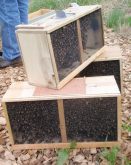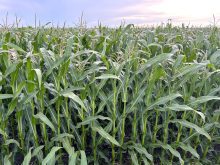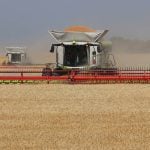It could have been so much better.
If China hadn’t got mad at us. If there hadn’t been a trade war. If PED hadn’t arrived. If the weather had been a bit more co-operative.
But the past year was also a reminder that efforts to make things better do pay off.
Look no further than grain transportation — an issue that has bedevilled Prairie farmers for decades. But this year, that picture changed dramatically.
Read Also

Canola’s clubroot success story
At one time, scientists, agronomists and growers were extremely worried clubroot would spread across the Prairies and devastate Canada’s canola industry.
Canada exported a record 44.6 million tonnes of grain in the 2018-19 crop year, with CP and CN Rail moving even more — a record 54.3 million tonnes.
It was a performance that even one of the biggest critics of the railways had to acknowledge as pretty impressive.
“It shows we’ve come a long way as a supply chain,” said Wade Sobkowich, executive director of the Western Grain Elevator Association. “This is something the industry has accomplished that it has never accomplished before in spite of some of the difficulties that are chronic and still exist.”
And that record is likely to be repeatedly broken as a wave of new high-throughput elevators coupled with a massive investment in high-capacity hopper cars come online. (This summer, Paterson Grain set a provincial record when it loaded 14,821 tonnes at its new Bowden terminal into a 1.6-mile-long train made up of the bigger hopper cars.)
The arrival of the porcine epidemic diarrhea virus (PEDv) in the province also illustrated that we have capabilities that other countries can only dream of.
The province’s financially stressed pork sector could scarcely have afforded a major disease outbreak when the first case of PEDv in Alberta was confirmed on Jan. 7. Although officials never discovered how the virus arrived at four operations in rapid succession at the start of the year (or why there were no more), Alberta’s biosecurity effort was extensive and impressive. For example, between Jan. 7 and May 9, provincial officials collected 11,881 samples (all negative) at 10 high-traffic pig sites (three abattoirs, three assembly yards, and four truck washes).
“It’s a bit like being a police investigator — looking at all the different possibilities this virus could have taken advantage of when it moved,” said Dr. Julia Keenliside, provincial veterinary epidemiologist.

The scarier threat is from African swine fever, which swept through China this year and resulted in the culling of upwards of half of its breeding sows (which means the country will be importing a lot more pork, and also more beef and poultry, for years to come).
The fear here is that the disease will arrive in North America via infected pork brought illegally by travellers. To lessen the chance of that happening, Ottawa is spending an extra $31 million to triple the number of detector dog teams at Canadian airports — one small piece in a largely unseen but extensive biosecurity system.
China and plant proteins
Of course, even the most extensive preparations can only take you so far.
In January, the president of the Canola Council of Canada was citing its “long-standing trading relationship with China” as he looked ahead to increased canola seed exports to that country.
“We think the underlying drivers of that relationship are very sound,” Jim Everson said at the start of the year. “China has a growing appetite for high-quality, reliable supplies of canola, and Canada has a growing supply to provide.”
Those relationships are likely intact, but with Beijing allowing only a trickle of imports since early March, they’re not of much use for now.
Replacing the lost Chinese canola sales was never going to be easy, but the years-ago investment in building domestic crushing plants paid off as those facilities went full out in the months following the Chinese ban.
An even more ambitious effort is underway when it comes to processing pulses, canola, hemp, and other crops to create a wide variety of food ingredients. Although a new plant protein ‘supercluster’ started the year with $153 million in federal funding in its pocket, this remained a very much in-the-background story in 2019.
Protein Industries Canada issued calls for proposals earlier in the year, with Calgary’s Botaneco Inc. (which has a unique way to process oil from canola, hemp, sunflower, and safflower seeds) receiving the first shot of funding ($4 million).
It’s a start, though whether the Prairies become a major processing centre for protein and other food components from plants remains to be seen. But the picture should become clearer in the coming year. In November, CEO Bill Greuel said 17 projects were given the green light to submit full proposals.
“We are expecting to have a significant portion of our $153 million committed into projects by the end of March 2020,” Greuel wrote in an update.
Evolving technology
A more quickly approaching target on the horizon is ‘smart’ agriculture.
With combine and tractor cabs starting to resemble cockpits, digital and computerized technology may seem like an old story. But the opening of a ‘Smart Farm’ at Olds College signals that technology is heading to a new level.
The operation, which has grown to more than 2,000 acres in little more than a year, employs soil monitors, digital weather stations, wireless grain bin sensors, multispectral imaging, precision ag technology, drones, data analytics, and artificial intelligence.
The goal is to evaluate the technology and identify ways to make it all work together.
“Technology is such a huge component of agriculture going into the future. It’s making agriculture more sustainable, more productive and more profitable,” said Joy Agnew, director of applied research at Olds College.
“But there’s still a lot of uncertainty and unknowns about the operability and ease of use and robustness of these technologies. Those are all questions that producers have, and without an actual testbed, it’s very difficult to answer those questions.”
Producers had a chance to ask some of those questions and see the Smart Farm’s technology this summer when the college hosted its first AgSmart event. The open house drew a big crowd but the true test, of course, is whether initiatives like this give Alberta producers an edge in the rapidly evolving world of ag tech and big data.
Research
This was a big topic in the past year for a couple of other reasons.
An effort to find support for two different types of seed royalties (a trailing royalty and an end point royalty) only succeeded in unifying farm groups in opposing both. Although cereal breeders say they can’t afford to develop new varieties if there’s no meaningful payback, farmers are leery of adding yet another expense in a business with very tiny margins.
Buy-in from producers for any model is a must, said Lynn Jacobson, president of the Alberta Federation of Agriculture.
“Unless the majority of people are willing to comply, it just is not going to fly,” Jacobson said this summer.
After extensive consultations early in the year, the effort to find some sort of solution has gone quiet, but is expected to return to the fore sooner or later.
Meanwhile, the new provincial government has moved quickly to change the face of ag research in this province. The United Conservative government plans to cut its own agricultural research spending by $34.1 million over the next four years.
Some of that money will apparently be flowing back to farmer-led research organizations, although details of how that would work haven’t been announced.
“We want to be able to partner with farmers so that the type of research the government is funding is, at the end of the day, something that benefits farmers,” Agriculture Minister Devin Dreeshen said earlier this winter.
“It’s not that we’re just looking at dollar figures — it’s actually about outcomes.”
And, as always, time will tell what those outcomes are.
















